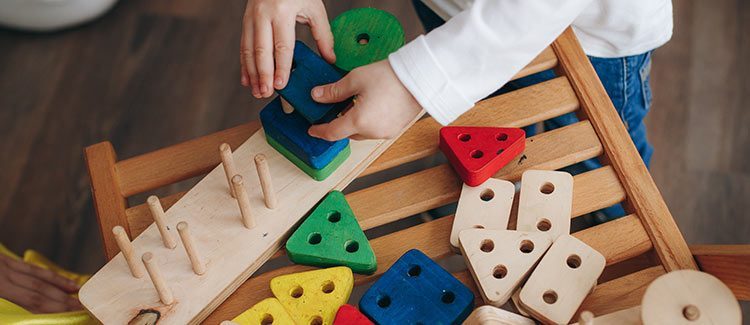Is your young child drawn to music, shapes, and colors? Most are, and it’s their natural inclination toward math. This math know-how emerges from your child’s experiences — like clapping along to songs — right alongside other developmental milestones— like being able to clap.
Yes, even babies learn math concepts early on, and it all starts with patterns.
Patterns are arrangements of things that repeat in a logical way. Those arrangements of colors, shapes, gestures, sounds, images, and numbers are a crucial concept for young kids and contributes heavily to their early math understanding. According to Zero to Three, a national nonprofit focused on early childhood development and learning, “Patterns help children learn to make predictions, to understand what comes next, to make logical connections, and to use reasoning skills.”
What’s more, understanding patterns helps your preschooler’s social development because it instills in them an understanding of the sequence of everyday routines, such as taking turns while playing or following school rules, such as raise your hand, wait to be called on, share what you have to say.
At this age, there are two types of patterns to look for and practice: repeating patterns (like red-blue-red-blue-red) and growing patterns (like small, medium, large). Luckily, both are hidden in your child’s daily activities and practicing these patterns is incredibly fun.
Color patterns
Color patterns are everywhere, and your child probably loves to spot — and create — them. Legos and colored blocks both lend themselves to creating color patterns: red-red-blue-yellow-red-red-blue-yellow. Your child may love coloring rainbows, which follow a color sequence; help them learn and follow the sequence.
Use arts and crafts to challenge kids to create and follow patterns. On Pinterest, check out age-appropriate paper snakes and colorful necklaces using cereal and candy as “beads.” Household items, such as ice cube trays and empty egg cartons can also be transformed into work stations where your child can create — and recreate — colorful play dough patterns.
Fun with food
Food display is a beautiful and helpful way your child can create patterns. Instruct your perky prep chef to put five pepperoni and three mushrooms on each slice of pizza. Having pancakes next weekend? Ask your preschooler to create decorative borders around each flapjack by alternating banana slices and chocolate chips. Instead of dumping your next fruit salad into a bowl, skewer the fruit onto sticks — shish kabobs! — with repeating patterns. (Get your child to lay out the fruit pattern, strawberry-banana-grape-orange-strawberry-banana-grape-orange for example; then, if your child’s motor skills allow, let him carefully skewer the fruit into patterns, too.)
Movin’ and groovin’ patterns
Simple movement patterns — the genesis of dance — can turn your next walk into a math and choreography lesson. “1-2-3-4-5-jump, that’s a pattern,” says Dr. Jie-Qi (Jackie) Chen, professor of Child Development at the Erikson Institute and co-author of Big Ideas of Early Mathematics: What Teachers of Young Children Need to Know.
“Go left, go right, left, right, that’s another pattern.” Encourage your kinetic kid to zig-zag-crouch-leap-wiggle until they’re exhausted — and educated.
Tick-tock patterns
As a society, we track time in specific patterns that are useful to teach your living-only-in-the-moment youngster. Explain seconds, minutes, and hours in terms your child can understand: she can hold her breath for a few seconds, she can wait a whole minute for your attention, and movies are a whole hour (or two) long. Give your child practice by setting up schedules: 10 minutes cleaning your room, 10 minutes playing. Explain the rhythm of the calendar (days of the week and months in the year are a great start), and ask them to determine how many days, weeks, and months until their birthday. Believe me, it’s a calculation they’re eager to solve.
Rhythm and music patterns
Research shows music and math are intertwined in our brains from an early age. The steady clap-clap-clap of hands (or bang-BANG-bang-BANG on pots and pans) are linked to your child’s math skills, like counting, sequencing, and spatial awareness. When you spot the beginning of a pattern, help your child add to it: teaching patterns through music will likely benefit your child’s cognitive abilities down the line.
Children’s nursery rhymes and music are often based on simple patterns. Many also require movement, like circling and falling down in “Ring Around the Rosie”.
Turn on the music, and let the patterns play. If you’re looking specifically for child-friendly tunes, LaMonica Hopkins, childcare and afterschool programs manager at GLIDE Foundation, highly recommends Greg & Steve, a Grammy Award-winning children’s musical duo. “They teach math concepts in many of their songs, which instruct listeners in musical movement games,” says Hopkins. Kids also love the patterns in jump rope games and in clapping songs, like Pat-a-Cake.
When you get one of those clapping or jumping songs stuck in your head, remember, it’s all worth it. You may be nurturing the next Taylor Swift, Jackson Pollack, Misty Copeland, or Stephen Hawkins.






